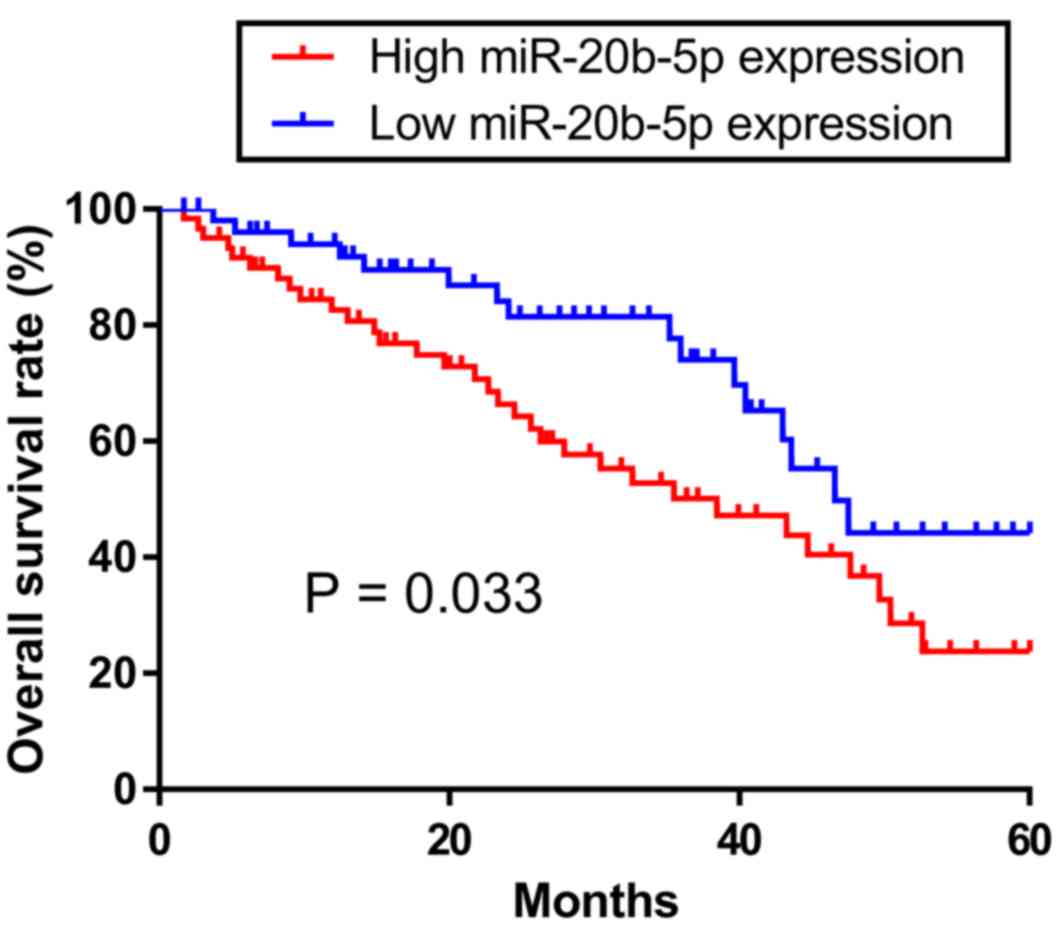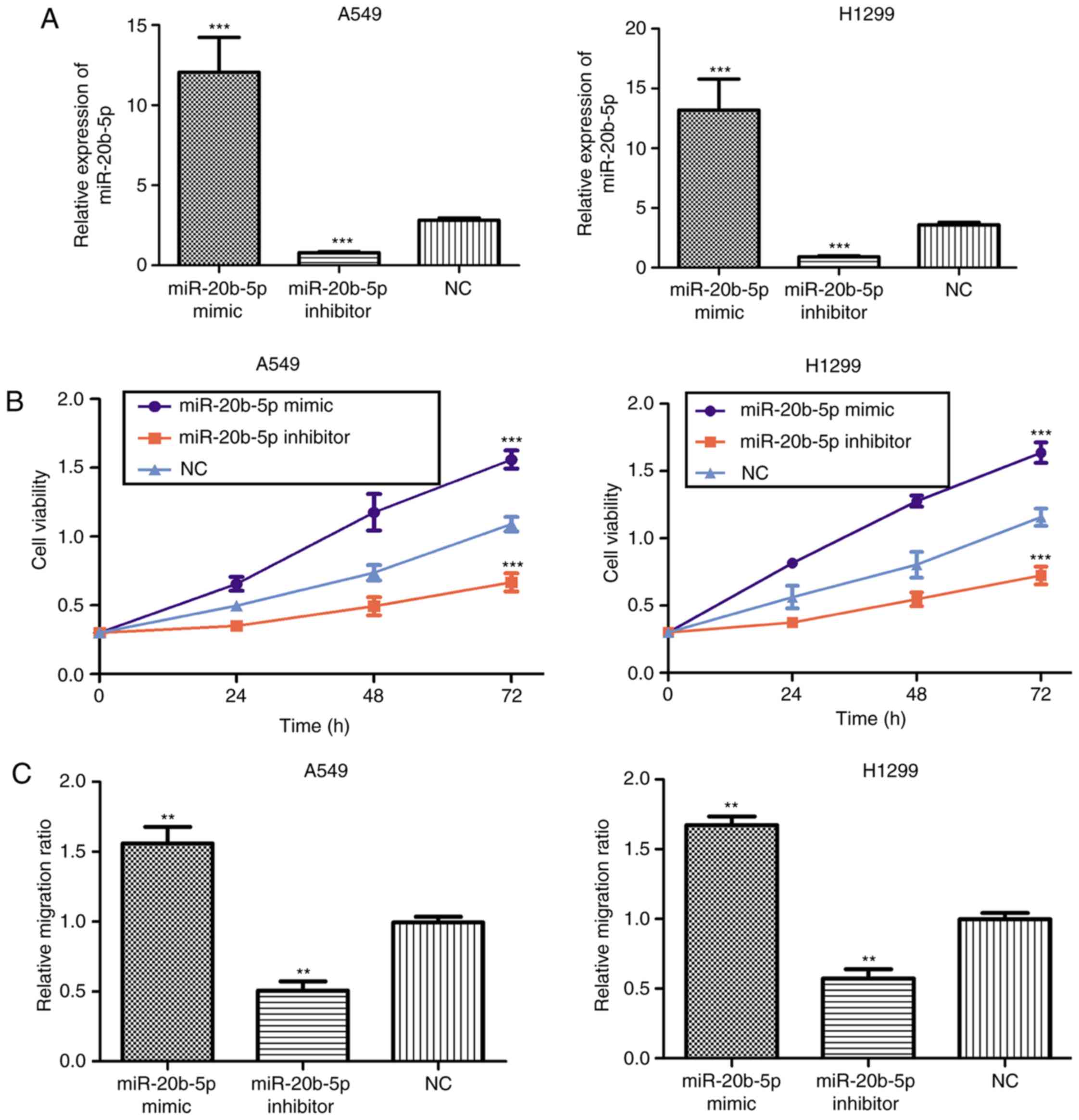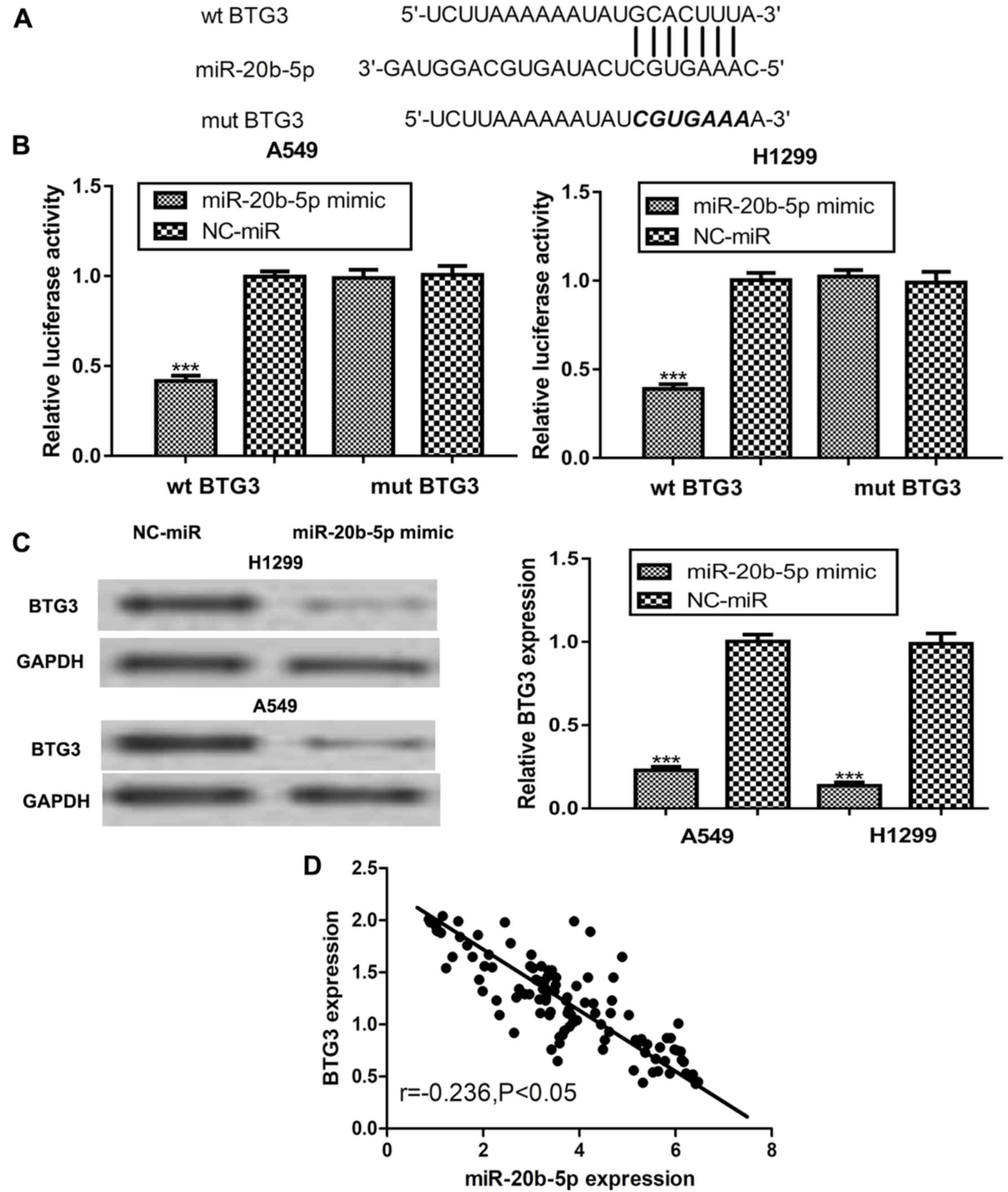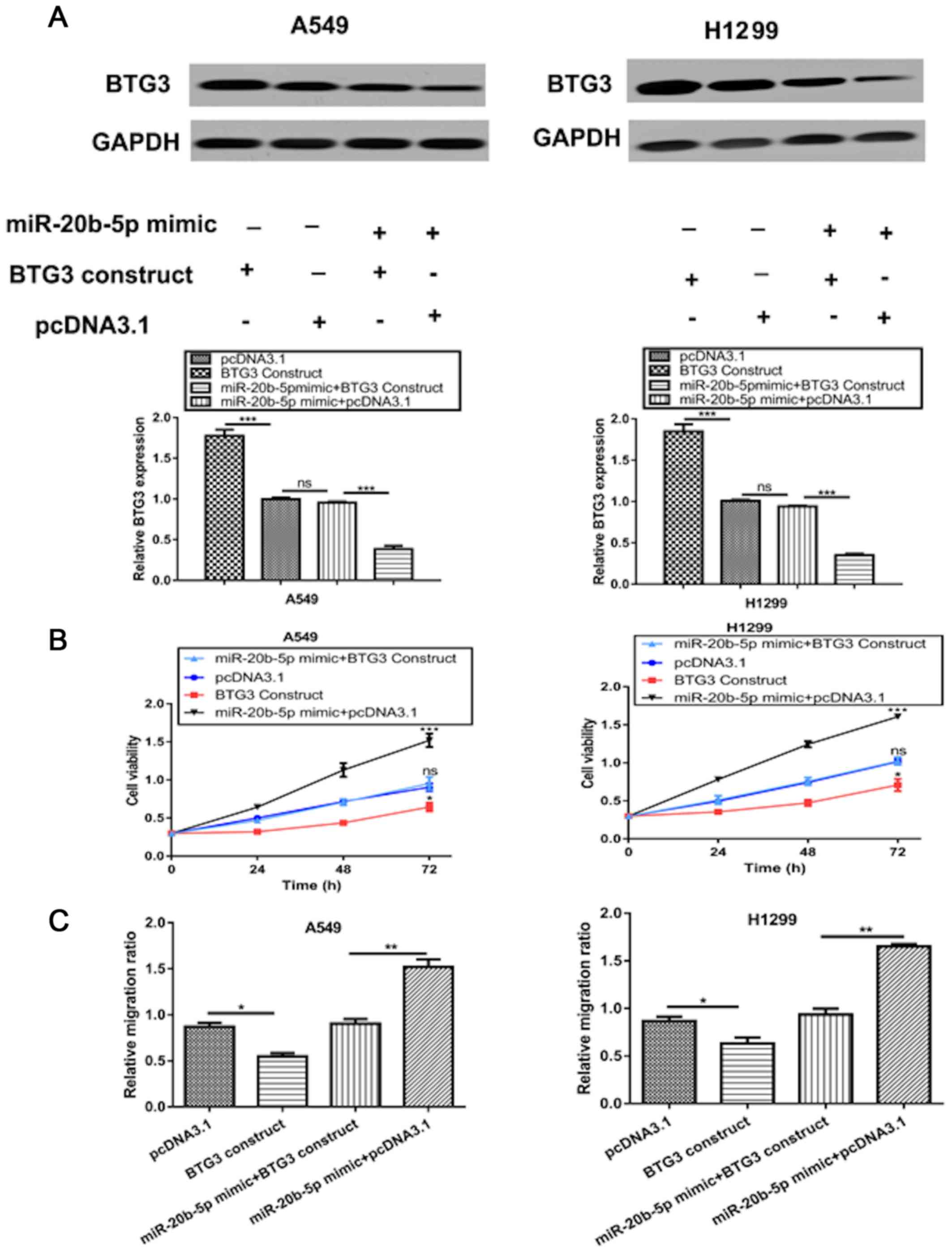Regulation of BTG3 by microRNA‑20b‑5p in non‑small cell lung cancer
- Authors:
- Published online on: May 7, 2019 https://doi.org/10.3892/ol.2019.10333
- Pages: 137-144
Abstract
Introduction
Lung cancer is one of the leading causes of cancer-associated mortality worldwide (1). Lung cancer can be classified into the following two subgroups: Small-cell lung cancer and non-small-cell lung cancer (NSCLC) (2). In 2017, NSCLC was reported to account for almost 80% of all cases of lung cancer worldwide (3). The overall survival rate for patients with NSCLC is poor, as diagnosis often occurs at an advanced stage due to a lack of efficient diagnosis methods (4). Investigations regarding the mechanisms underlying the development and progression of NSCLC may improve the precise diagnosis of the disease.
MicroRNAs (miRNAs or miRs) are a family of endogenous RNAs with a length of ~8–25 nucleotides (5). miRNAs have been reported to serve crucial roles in the development and progression of human cancer as they participate in almost all cell malignancy behaviors (6–8). No miRNA has been used as diagnostic or prognostic marker in the clinic; however, numerous studies have highlighted the significance of these molecules in human cancer (9,10). miR-20b-5p is located at human chromosome Xq26.2, a site that has previously been reported to be associated with the initiation or progression of a number of types of cancer (11). Recently, it has been reported that miR-20b-5p is abnormally expressed in human cancer and functions as a tumor suppressor or oncogene in a context-dependent manner (12–14). Li et al (12) demonstrated that miR-20b-5p expression was downregulated in renal cell carcinoma, in the first study to reveal a tumor suppressive role of miR-20b-5p. A recent study (13) demonstrated that miR-20b-5p was upregulated in breast cancer and could be used as a biomarker to diagnose breast cancer. A study using RT-qPCR revealed that an increased expression level miR-20b-5p could effectively distinguish NSCLC from a control (14). However, the biological functions of miR-20b-5p in NSCLC remain unclear.
The present study revealed that miR-20b-5p is overexpressed in NSCLC tissues and cell lines. Cell Counting Kit-8 (CCK-8) and wound-healing assays were performed to investigate the effects of miR-20b-5p expression on NSCLC cell proliferation and migration. In addition, B-cell translocation gene 3 (BTG3) was identified as a direct target of miR-20b-5p by using bioinformatics, a luciferase activity reporter assay and western blot analysis.
Materials and methods
Clinical specimens
A total of 113 pairs of tumor tissue samples and adjacent non-cancerous tissue samples (≥2 cm away from the tumor) were collected from patients with NSCLC (57 male and 56 female; 56.7±4.2 years) who underwent treatment at Guangzhou General Hospital of The People's Liberation Army (PLA) (Guangzhou, China) between March 2011 and November 2012. The tissue samples were snap-frozen in liquid nitrogen following surgery and stored at −80°C prior to further use. Tumor stage was classified according to the American Joint Committee on Cancer staging system (15). The present study was approved by the Ethics Committee of Guangzhou General Hospital of PLA (Guangzhou, China). Written informed consent was obtained from all recruited patients.
Cell culture and transfection
A549, H1299, and 16HBE cell lines were purchased from the Cell Bank of the Chinese Academy of Sciences (Shanghai, China). All cells were cultured in RPMI-1640 medium (Invitrogen; Thermo Fisher Scientific, Inc., Waltham, MA, USA) supplemented with 10% fetal bovine serum (Invitrogen; Thermo Fisher Scientific, Inc.), 100 U/ml penicillin and 100 µg/ml streptomycin in a humidified incubator at 37°C containing 5% CO2. The miR-20b-5p mimic (5′-CAAAGUGCUCAUAGUGCAGGUAG-3′), inhibitor (5′-CUACCUGCACUAUGAGCACUUUG-3′) and negative control (NC; 5′-GCUAGAUGCACUCAUCUCUACGU-3′) were obtained from Shanghai GenePharma Co., Ltd. (Shanghai, China). The BTG3 expression construct and the pcDNA3.3 NC were purchased from GenScript (Nanjing, China). Lipofectamine® 2000 (Invitrogen; Thermo Fisher Scientific, Inc.) was used for cell transfections, according to the manufacturer's protocol. Subsequent experiments were performed 48 h after transfection.
RT-qPCR
Total RNA from tissues and cell lines was extracted using TRIzol® reagent (Invitrogen; Thermo Fisher Scientific, Inc.). cDNA was synthesized using a miScript reverse transcription kit (Qiagen GmbH, Hilden, Germany). RT-qPCR was performed with a SYBR-Green PCR master mix (Thermo Fisher Scientific, Inc.) on a 7500 Real-time PCR system (Thermo Fisher Scientific, Inc.). Primers were synthesized by GenScript (Nanjing, China) with the following sequences: miR-20b-5p forward, 5′-TGTCAACGATACGCTACGA-3′ and reverse, 5′-GCTCATAGTGCAGGTAGA-3′; and U6 forward, 5′-CTCGCTTCGGCAGCACA-3′ and reverse, 5′-AACGCTTCACGAATTTGCGT-3′. Relative expression levels were calculated using the 2−ΔΔCq method with U6 as the internal control (16). The thermocycling conditions were as follows: 95°C for 2 min, 95°C for 10 sec, 55°C for 30 sec and 72°C for 30 sec, for 40 cycles. Each experiment was performed in triplicate.
Protein sample extraction and western blot analysis
Total protein from tissues and cell lines was extracted using RIPA lysis buffer (Invitrogen; Thermo Fisher Scientific, Inc.), according to the manufacturer's protocol. Protein concentration was measured using a BCA kit (Beyotime Institute of Biotechnology, Haimen, China). The extracted protein samples (50 µg) were separated by 10% SDS-PAGE and then transferred to polyvinylidene fluoride membranes (Invitrogen; Thermo Fisher Scientific, Inc.). Subsequently, the membranes were blocked with 5% non-fat milk for 2 h at room temperature prior to incubation with primary antibodies targeting BTG3 (1:1,000; catalog no. ab112938; Abcam, Cambridge, MA, USA) or GAPDH (1:1,000; catalog no. ab181602; Abcam) overnight at 4°C. Subsequently, the membranes were incubated with horseradish peroxidase-conjugated goat anti-rabbit secondary antibody (1:5,000; catalog no. ab6721; Abcam) for 1 h at room temperature. Protein signals were visualized using an enhanced chemiluminescence detection system (Beyotime Institute of Biotechnology) and analyzed with ImageJ 1.42 software (National Institutes of Health, Bethesda, MD, USA).
CCK-8 assay
Cell proliferation ability was measured using a CCK-8 assay (Beyotime Institute of Biotechnology), according to the manufacturer's protocol. Briefly, the A549 and H1299 cells were seeded at a density of 5,000 cells/well in a 96-well plate and incubated in RPMI-1640 medium supplemented with 10% fetal bovine serum, 100 U/ml penicillin and 100 µg/ml streptomycin. CCK-8 reagent was added to each well at 0, 24, 48 and 72 h, and the cells were further incubated for 2 h. The absorbance was measured at 450 nm using an ELISA reader (BioTek Instruments, Inc., Winooski, VT, USA).
Wound-healing assay
Cell migration ability was measured using a wound-healing assay, as described previously (17). Briefly, 5×105 cells (A549 and H1299) were seeded in a 12-well plate and cultured until ~80% confluence. A wound was then created using a sterile 200-µl pipette tip at the surface of the cells in each well. Subsequently, the cells were washed with PBS to remove cell debris. Images were acquired using a Leica DMI 6000B inverted light microscope (Leica Microsystems, Inc., Buffalo Grove, IL, USA) at 0 or 24 h after the wounds were made to measure the wound width.
Bioinformatic analysis
miR-20b-5p targets were predicted and analyzed using the online miRNA targets prediction algorithm TargetScan (www.targetscan.org). Targets to be investigated were selected based on the reported gene functions. These results revealed that BTG3 may be a target of miR-20b-5p as it contains a miR-20b-5p binding site in its 3′-untranslated region (3′-UTR).
Dual-luciferase reporter assay
The putative wild-type (wt) and mutant (mut) miR-20b-5p binding sequences were cloned into a pGL3 vector (Promega Corporation, Madison, WI, USA). Cells were co-transfected with the built constructs along with miR-20b-5p mimic or NC using Lipofectamine 2000 (Invitrogen; Thermo Fisher Scientific, Inc.). Luciferase activity was measured using a Dual-Luciferase assay kit (Promega Corporation) 48 h after transfection. Data were normalized to the activity of the Renilla luciferase reference plasmid.
Statistical analysis
Data were analyzed with GraphPad Prism 6 software (GraphPad Software, Inc., La Jolla, CA, USA) and presented as the mean ± standard deviation. Analysis between two groups was performed with a paired Student's t-test. One-way analysis of variance with Tukey's post hoc test was used for the comparison of multiple groups. A χ2 test was performed to analyze the associations of miR-20b-5p expression and clinicopathological features. The correlation between miR-20b and BTG3 was analyzed with Pearson's correlation. Survival analysis was performed with Kaplan-Meier curve and log-rank test. P<0.05 was considered to indicate a statistically significant difference.
Results
miR-20b-5p is upregulated in NSCLC tissues and cell lines
It was identified that the miR-20b-5p expression level was significantly higher in NSCLC tissues compared with normal adjacent tissues (Fig. 1A). Furthermore, the level of miR-20b-5p in NSCLC cell lines was investigated, which revealed that the expression level of miR-20b-5p was significantly higher in the NSCLC cell lines A549 and H1299 compared with the normal 16HBE cell line (Fig. 1B).
Clinical significance of miR-20b-5p expression in NSCLC
Patients with NSCLC were classified into high or low miR-20b-5p expression groups based on the median miR-20b-5p expression level. Patients with an miR-20b-5p expression level equal to or higher than the median value (4.12) were classified into the high expression group. Otherwise, the patients were classified into the low expression group. It was identified that miR-20b-5p expression was not significantly associated with age, sex, hepatitis B surface antigen and smoking status (Table I). However, significant differences were revealed between miR-20b-5p expression level and tumor size and tumor stage. Kaplan-Meier analysis and a log-rank test were performed to analyze the association of miR-20b-5p expression with the overall survival rate. The overall survival rate of patients with a high miR-20b-5p expression level was significantly lower compared with those with a low miR-20b-5p expression level (P=0.033; Fig. 2).
Table I.Association between miR-20b-5p expression and clinicopathological features of patients with non-small cell lung cancer. |
Knockdown of miR-20b-5p inhibits NSCLC cell proliferation and migration
The in vitro biological function of miR-20b-5p was assessed by CCK-8 assay and a wound-healing assay. The expression level of miR-20b-5p in NSCLC cells was altered by transfection with miR-20b-5p mimic or inhibitor. It was demonstrated that transfection with miR-20b-5p mimic significantly increased the level of miR-20b-5p, while miR-20b-5p inhibitor significantly downregulated the level of miR-20b-5p (Fig. 3A). CCK-8 assay results demonstrated that the proliferation ability of NSCLC cells was significantly decreased following transfection with miR-20b-5p inhibitor but significantly increased by miR-20b-5p mimic (Fig. 3B). Furthermore, a wound-healing assay revealed that the migratory distance of NSCLC cells transfected with miR-20b-5p mimic was significantly larger compared with the NC group. In addition, the migratory distance was significantly smaller for the NSCLC cells transfected with inhibitor compared with the NC group (Fig. 3C). These data indicate that miR-20b-5p overexpression significantly increases cell proliferation and migration.
BTG3 is a target of miR-20b-5p in NSCLC
Online targets analysis revealed that BTG3 contains a putative binding site for miR-20b-5p in its 3′-UTR (Fig. 4A). Furthermore, a dual-luciferase reporter assay demonstrated that transfection with miR-20b-5p mimic significantly decreased the luciferase activity in NSCLC cells transfected with wt BTG3 but not in those transfected with mut BTG3 (Fig. 4B). Subsequently, BTG3 protein expression was examined in the miR-20b-5p mimic or NC-transfected NSCLC cells. It was identified that transfection with miR-20b-5p mimic significantly decreased BTG3 protein expression in NSCLC cells compared with that in the NC group (Fig. 4C). Furthermore, an inverse correlation was revealed between miR-20b-5p and BTG3 expression levels in NSCLC tissues (Fig. 4D). These results suggest that BTG3 is a direct target of miR-20b-5p.
miR-20b-5p promotes NSCLC cell proliferation and migration by targeting BTG3
To validate BTG3 as a functional target of miR-20b-5p, NSCLC cells were co-transfected with a BTG3 expression construct and miR-20b-5p mimic. Western blot analysis demonstrated that transfection with the BTG3 expression construct markedly increased the protein level of BTG3 in NSCLC cells (Fig. 5A). Furthermore, transfection with miR-20b-5p mimic reduced the stimulation effect of BTG3 expression construct on the expression level of BTG3 (Fig. 5A). As presented in Fig. 5B, overexpression of BTG3 significantly reversed the stimulation effect of miR-20b-5p mimic on cell proliferation. Similarly, the promoting effect of miR-20b-5p mimic on cell migration was significantly inhibited by BTG3 overexpression (Fig. 5C).
Discussion
miR-20b-5p, along with miR-17-92 and miR-106b-25 clusters, form a large and highly conserved miRNA family, termed the miR-17 family (18). Members of the miR-17 family have been reported to be highly expressed in human cancer types and have been suggested to function as oncogenes (19,20). In addition, previous studies have demonstrated that miR-20b-5p can regulate a number of cell behaviors, including cell proliferation, cell migration and cell apoptosis (12,13). A previous study has examined the expression level of miR-20b-5p in NSCLC (14); however, to the best of our knowledge, no previous study has investigated its clinical significance in NSCLC.
The present study identified that miR-20b-5p expression was upregulated in NSCLC tissues, which is the same result that was observed in a high throughput RT-qPCR experiment (14). The investigation of miR-20b-5p expression level in NSCLC cell lines and a normal cell line also revealed that miR-20b-5p expression was upregulated in NSCLC. Subsequently, the associations between miR-20b-5p expression and clinicopathological parameters were evaluated, which revealed that miR-20b-5p expression was significantly associated with two classical tumor malignancy indicators, tumor size and tumor stage. Furthermore, it was identified that a high expression level of miR-20b-5p predicts a worse 5-year overall survival rate.
It has been established that miRNAs exert their biological roles via regulation of cancer-associated genes (7–10). In addition, miR-20b-5p has been reported to regulate a number of human genes in cancer (12). BTG3 is a target of p53 and a negative regulator of cell cycle progression and cell proliferation (21,22). BTG3 expression has been identified to be downregulated in colorectal cancer and reported to regulate cell proliferation, migration, invasion, the cell cycle and apoptosis (23). Furthermore, BTG3 overexpression can inhibit epithelial ovarian cancer cell proliferation and invasion but promote cell apoptosis via regulation of the AKT/glycogen synthase kinase-3β/β-catenin pathway (24). It has been reported that BTG3 expression is reduced in NSCLC and functions as a tumor suppressor (25).
Notably, the present study identified that the 3′-UTR of BTG3 contains a binding site for miR-20b-5p. Therefore, it was then investigated whether miR-20b-5p and BTG3 are associated in NSCLC. Western blot analysis revealed that BTG3 expression could be regulated by miR-20b-5p, which indicates that BTG3 is a direct target of miR-20b-5p. Further in vitro functional assays revealed that miR-20b-5p overexpression could promote NSCLC cell proliferation and migration. These results suggest that miR-20b-5p functions as an oncogene in NSCLC, which is a role that has been identified in other cancer types, including breast and prostate cancer (13,26). Mechanistic studies revealed that BTG3 was a functional target of miR-20b-5p. Notably, overexpression of BTG3 only partially reversed the effects of miR-20b-5p mimic on cell proliferation and migration, which indicates that other molecules may also be involved in this process. For example, it has been reported that miR-20b-5p regulates myoblast differentiation and proliferation by directly regulating the expression of E2F transcription factor 1 (E2F1) (27). Additionally, BTG3 binds to and inhibits E2F1 via an N-terminal domain to regulate growth (28). Therefore, it is reasonable to suggest that E2F1 may also participate in the miR-20b-5p-mediated NSCLC cell behaviors and this requires further investigation in the future.
In conclusion, the present study revealed that miR-20b-5p expression is elevated in NSCLC and overexpression of miR-20b-5p can promote cell proliferation and migration by targeting BTG3. Notably, a high miR-20b-5p expression level was identified to be associated with a worse 5-year overall survival rate. Therefore, miR-20b-5p may serve as a novel target for NSCLC early diagnosis or treatment.
Acknowledgements
Not applicable.
Funding
Not applicable.
Availability of data and materials
The datasets used and/or analyzed during the present study are available from the corresponding author on reasonable request.
Authors' contributions
LP, SL, DL, and YX conceived and deigned the study. LP, SL, YL, MW, XF, YZ, WZ, DL and YX performed the experiments and were major contributors in writing the manuscript. All authors read and approved the final manuscript.
Ethics approval and consent to participate
The study was approved by Ethic Committee of Guangzhou General Hospital of PLA (Guangzhou, China). Written informed consent was obtained from all enrolled patients.
Patient consent for publication
Not applicable.
Competing interests
The authors declare that they have no competing interests.
References
|
Torre LA, Bray F, Siegel RL, Ferlay J, Lortet-Tieulent J and Jemal A: Global cancer statistics, 2012. CA Cancer J Clin. 65:87–108. 2015. View Article : Google Scholar : PubMed/NCBI | |
|
Gompelmann D, Eberhardt R and Herth FJ: Advanced malignant lung disease: What the specialist can offer. Respiration. 82:111–123. 2011. View Article : Google Scholar : PubMed/NCBI | |
|
Kang M, Shi J, Peng N and He S: MicroRNA-211 promotes non-small-cell lung cancer proliferation and invasion by targeting MxA. Onco Targets Ther. 10:5667–5675. 2017. View Article : Google Scholar : PubMed/NCBI | |
|
Siegel RL, Miller KD and Jemal A: Cancer statistics, 2017. CA Cancer J Clin. 67:7–30. 2017. View Article : Google Scholar : PubMed/NCBI | |
|
Mallory AC and Vaucheret H: MicroRNAs: Something important between the genes. Curr Opin Plant Biol. 7:120–125. 2004. View Article : Google Scholar : PubMed/NCBI | |
|
Bartel DP: MicroRNAs: Genomics, biogenesis, mechanism, and function. Cell. 116:281–297. 2004. View Article : Google Scholar : PubMed/NCBI | |
|
Hwang HW and Mendell JT: MicroRNAs in cell proliferation, cell death, and tumorigenesis. Br J Cancer. 94:776–780. 2006. View Article : Google Scholar : PubMed/NCBI | |
|
Calin GA and Croce CM: MicroRNA signatures in human cancers. Nat Rev Cancer. 6:857–866. 2006. View Article : Google Scholar : PubMed/NCBI | |
|
Florczuk M, Szpechcinski A and Chorostowska-Wynimko J: miRNAs as biomarkers and therapeutic targets in non-small cell lung cancer: Current perspectives. Target Oncol. 12:179–200. 2017. View Article : Google Scholar : PubMed/NCBI | |
|
Zhang B, Pan X, Cobb GP and Anderson TA: microRNAs as oncogenes and tumor suppressors. Dev Biol. 302:1–12. 2007. View Article : Google Scholar : PubMed/NCBI | |
|
Saleiban A, Faxälv L, Claesson K, Jönsson JI and Osman A: miR-20b regulates expression of proteinase-activated receptor-1 (PAR-1) thrombin receptor in melanoma cells. Pigment Cell Melanoma Res. 27:431–441. 2014. View Article : Google Scholar : PubMed/NCBI | |
|
Li Y, Chen D, Jin L, Liu J, Su Z, Li Y, Gui Y and Lai Y: MicroRNA-20b-5p functions as a tumor suppressor in renal cell carcinoma by regulating cellular proliferation, migration and apoptosis. Mol Med Rep. 13:1895–1901. 2016. View Article : Google Scholar : PubMed/NCBI | |
|
Li M, Zhou Y, Xia T, Zhou X, Huang Z, Zhang H, Zhu W, Ding Q and Wang S: Circulating microRNAs from the miR-106a-363 cluster on chromosome X as novel diagnostic biomarkers for breast cancer. Breast Cancer Res Treat. 170:257–270. 2018. View Article : Google Scholar : PubMed/NCBI | |
|
Leidinger P, Brefort T, Backes C, Krapp M, Galata V, Beier M, Kohlhaas J, Huwer H, Meese E and Keller A: High-throughput qRT-PCR validation of blood microRNAs in non-small cell lung cancer. Oncotarget. 7:4611–4623. 2016. View Article : Google Scholar : PubMed/NCBI | |
|
Greene FL, Page DL, Fleming ID, Fritz A, Balch CM and Haller DG: AJCC cancer staging handbook from the AJCC cancer staging manual. (6th). Springer. (New York). 2002. | |
|
Livak KJ and Schmittgen TD: Analysis of relative gene expression data using real-time quantitative PCR and the 2(-Delta Delta C(T)) method. Methods. 25:402–408. 2001. View Article : Google Scholar : PubMed/NCBI | |
|
Gao X, Zhao H, Diao C, Wang X, Xie Y, Liu Y, Han J and Zhang M: miR-455-3p serves as prognostic factor and regulates the proliferation and migration of non-small cell lung cancer through targeting HOXB5. Biochem Biophys Res Commun. 495:1074–1080. 2018. View Article : Google Scholar : PubMed/NCBI | |
|
Tanzer A and Stadler PF: Molecular evolution of a microRNA cluster. J Mol Biol. 339:327–335. 2004. View Article : Google Scholar : PubMed/NCBI | |
|
Hayashita Y, Osada H, Tatematsu Y, Yamada H, Yanagisawa K, Tomida S, Yatabe Y, Kawahara K, Sekido Y and Takahashi T: A polycistronic microRNA cluster, miR-17-92, is overexpressed in human lung cancers and enhances cell proliferation. Cancer Res. 65:9628–9632. 2005. View Article : Google Scholar : PubMed/NCBI | |
|
Landais S, Landry S, Legault P and Rassart E: Oncogenic potential of the miR-106-363 cluster and its implication in human T-cell leukemia. Cancer Res. 67:5699–5707. 2007. View Article : Google Scholar : PubMed/NCBI | |
|
Cheng YC, Lin TY and Shieh SY: Candidate tumor suppressor BTG3 maintains genomic stability by promoting Lys63-linked ubiquitination and activation of the checkpoint kinase CHK1. Proc Natl Acad Sci USA. 110:5993–5998. 2013. View Article : Google Scholar : PubMed/NCBI | |
|
Majid S, Dar AA, Ahmad AE, Hirata H, Kawakami K, Shahryari V, Saini S, Tanaka Y, Dahiya AV, Khatri G and Dahiya R: BTG3 tumor suppressor gene promoter demethylation, histone modification and cell cycle arrest by genistein in renal cancer. Carcinogenesis. 30:662–670. 2009. View Article : Google Scholar : PubMed/NCBI | |
|
Lv C, Wang H, Tong Y, Yin H, Wang D, Yan Z, Liang Y, Wu D and Su Q: The function of BTG3 in colorectal cancer cells and its possible signaling pathway. J Cancer Res Clin Oncol. 144:295–308. 2018. View Article : Google Scholar : PubMed/NCBI | |
|
An Q, Zhou Y, Han C, Zhou Y, Li F and Li D: BTG3 overexpression suppresses the proliferation and invasion in epithelial ovarian cancer cell by regulating AKT/GSK3β/β-catenin signaling. Reprod Sci. 24:1462–1468. 2017. View Article : Google Scholar : PubMed/NCBI | |
|
Chen X, Chen G, Cao X, Zhou Y, Yang T and Wei S: Downregulation of BTG3 in non-small cell lung cancer. Biochem Biophys Res Commun. 437:173–178. 2013. View Article : Google Scholar : PubMed/NCBI | |
|
Guo J, Xiao ZW, Yu XW and Cao RF: miR-20b promotes cellular proliferation and migration by directly regulating phosphatase and tensin homolog in prostate cancer. Oncol Lett. 14:6895–6900. 2017.PubMed/NCBI | |
|
Luo W, Li G, Yi Z, Nie Q and Zhang X: E2F1-miR-20a-5p/20b-5p auto-regulatory feedback loop involved in myoblast proliferation and differentiation. Sci Rep. 6:279042016. View Article : Google Scholar : PubMed/NCBI | |
|
Ou YH, Chung PH, Hsu FF, Sun TP, Chang WY and Shieh SY: The candidate tumor suppressor BTG3 is a transcriptional target of p53 that inhibits E2F1. EMBO J. 26:3968–3980. 2007. View Article : Google Scholar : PubMed/NCBI |














